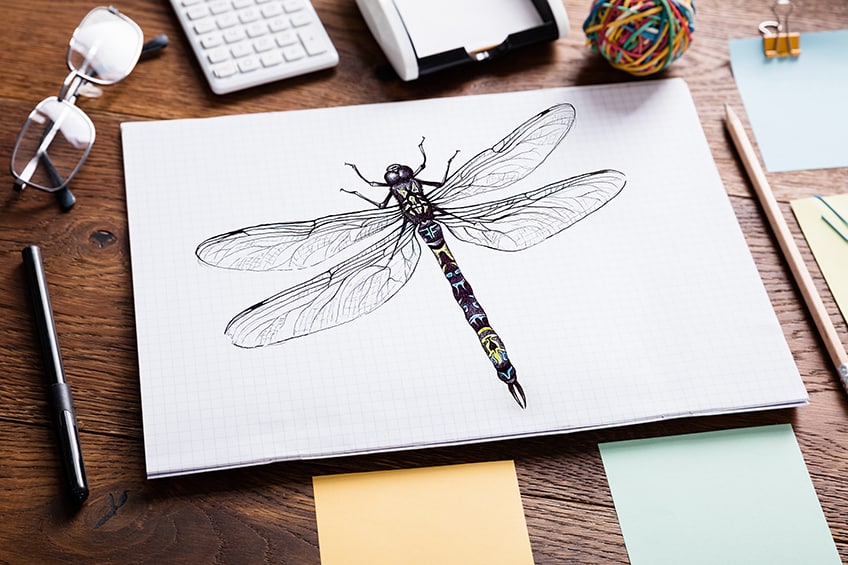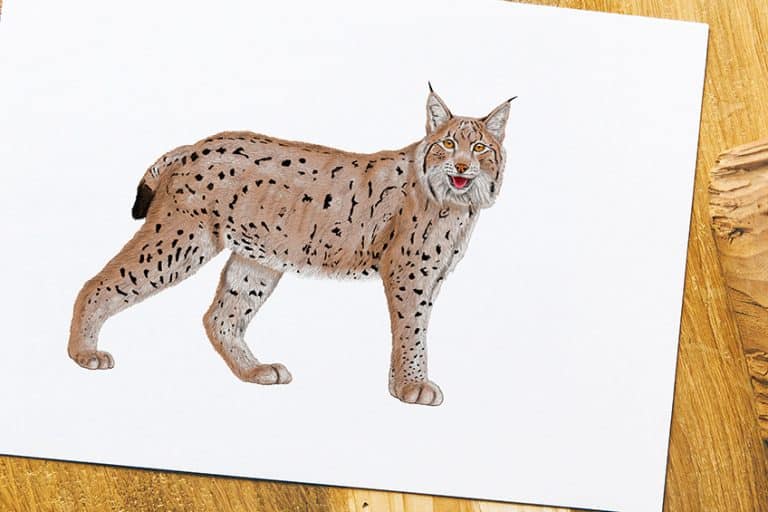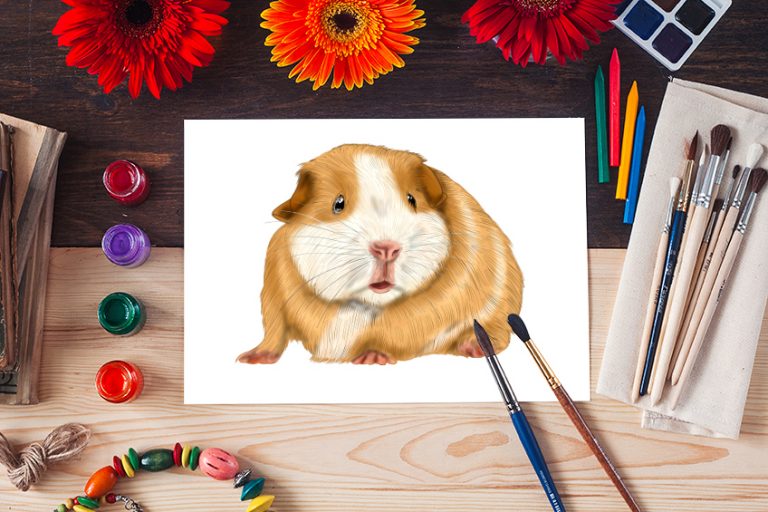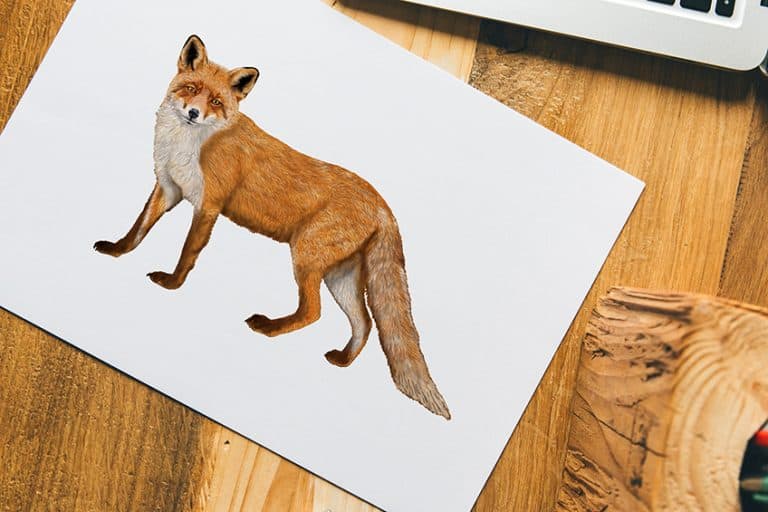How to Draw a Dragonfly – Realistic Drawing Tutorial
Learning how to draw a dragonfly is a really interesting topic because once you know the method, you can play around with giving your dragonfly further details. Creating a realistic dragonfly drawing is also really easy and can be done with a few simple tips and tricks. Dragonflies are very unique and the meaning around them changes according to how they are contextualized within a drawing. Dragonfly art functions within various genres and can be a mystical, scientific, horrific, or peaceful addition to an artwork. Their structure is beautiful and grotesque which gives them this strange appeal and defines them as a symbol of mysticism and fantasy. Whether you create a simple dragonfly illustration as a singular artwork or decide to create a realistic dragonfly drawing that functions as an addition to a larger artwork, this creature can be used in all sorts of ways. Dragonflies are beautiful and fun to draw, knowing how to draw a dragonfly is a great asset to have in your drawing repertoire.
An Easy Guide to Drawing a Dragonfly
As we learn how to draw a dragonfly, we will learn very quickly that the drawing process is quite simple and easy. A dragonfly drawing may seem complex; however, dragonflies are pretty easy to draw using simple line work.
The use of symmetry and simple linework are some basic tricks that we can use to create a realistic dragonfly drawing.
In this tutorial, we will see how we can transform a dragonfly sketch into a more realistic dragonfly drawing. We will also see how the dragonfly coloring and little additional details can develop the basic dragonfly sketch into a more realistic dragonfly drawing. This tutorial helps you to create a beautiful and realistic dragonfly drawing using a few simple tools that are easily accessible.
Necessary Materials
For this tutorial on how to draw a dragonfly, we will use very common materials. We will start with a simple dragonfly sketch which we will develop with a pencil. We want to make sure we have an eraser and a sharpener for the pencil drawing process of the tutorial, that way we can have sharp lines and erase any silly mistakes along the way.
Dragonflies are quite dark, which means as we create our dragonfly illustration, we want to capture this quality.
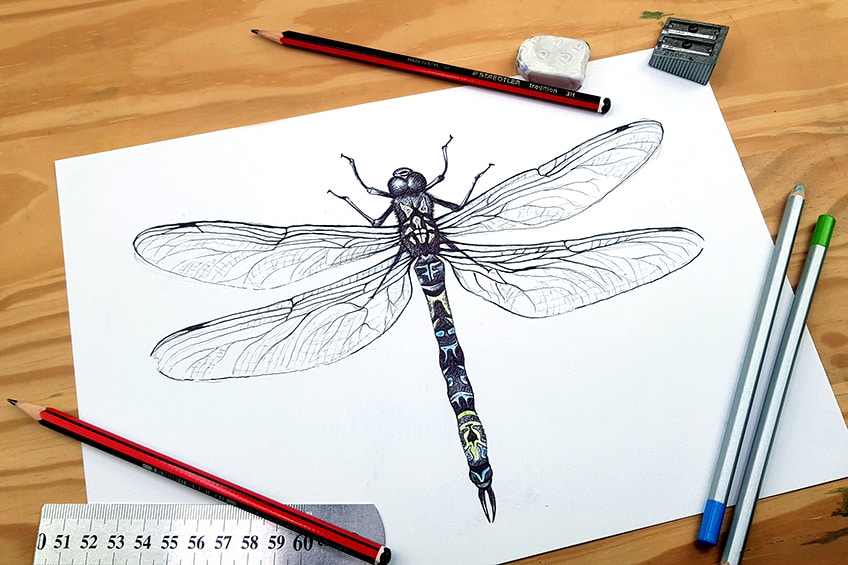
- HB pencil
- Colored pencils
- Ballpoint pen
- Eraser
- Sharpener
- Good paper (200 g/m – 250 g/m recommended)
Step-by-Step Instructions on How to Draw a Dragonfly
In this tutorial, learning how to draw a dragonfly is broken up into a few simple digestible steps. We will begin the tutorial with a simple dragonfly sketch, where we use a straight line to help create symmetry within the drawing. We will start from the head and go all the way down to the tail. We will then proceed with our pencil sketch by drawing the legs and wings of the dragonfly.
Once we have our dragonfly pencil sketch, we can then proceed to an ad in pen marks using a ballpoint pen. Using our ballpoint pen, we will start to add color and shading to the insect.
We will use the pencil sketch to guide the pen drawing process as we go over each feature of the dragonfly. Lastly, we will add some hints of color to give the dragonfly a nuanced quality, making it unique and giving a more organic quality. Now that we know what to expect, let us go through this tutorial on how to draw a dragonfly!
Sketching the Body
We can begin by drawing a simple vertical line down the page using our pencil and ruler. We want to make a simple line through the page which will help us to draw a symmetrical dragonfly body. From here we can begin to draw the head and body of the dragonfly. A good suggestion is to get an image from the internet as a reference, however, it is not necessary.
The head and body or thorax could be described as a bean shape connected to two circles. The circles would be the eyes and the bean shape would be the body/thorax of the dragonfly.
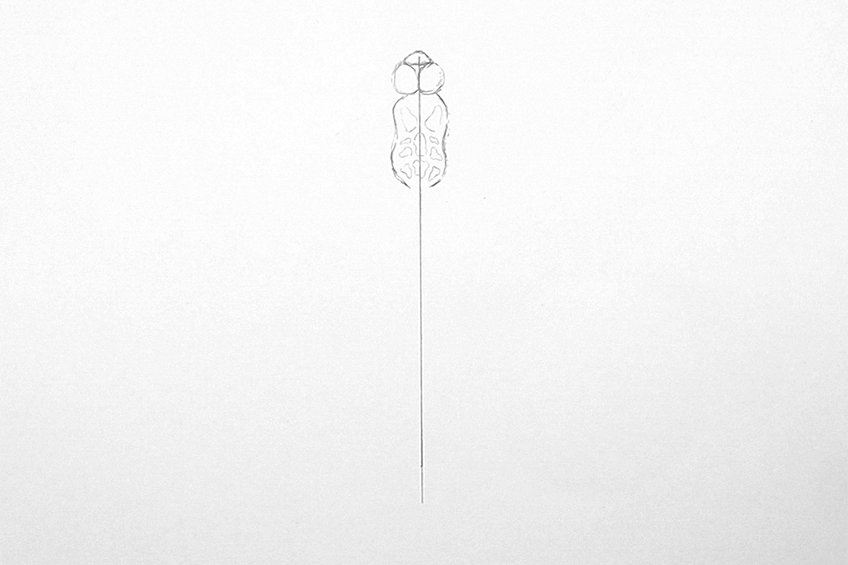
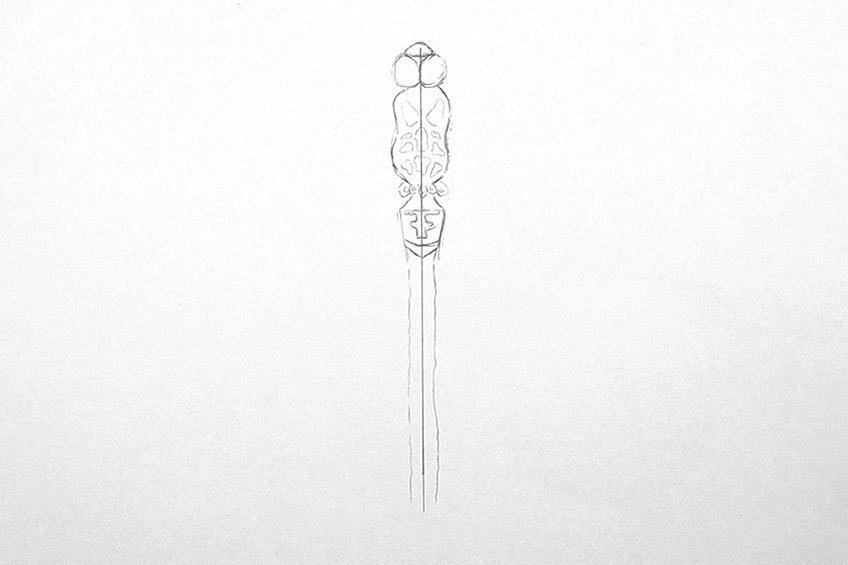
In the next part, we want to draw in the lower section of the thorax, which could be described as an upside-down cone shape.
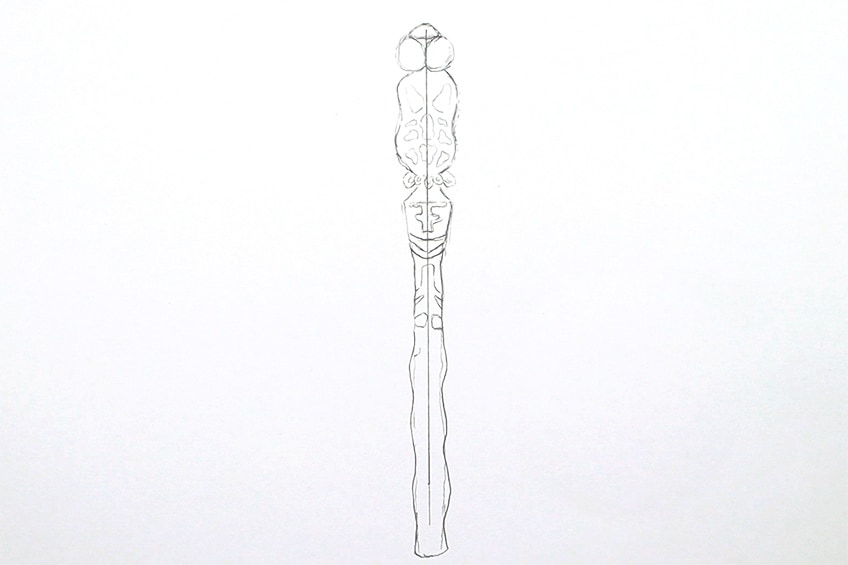
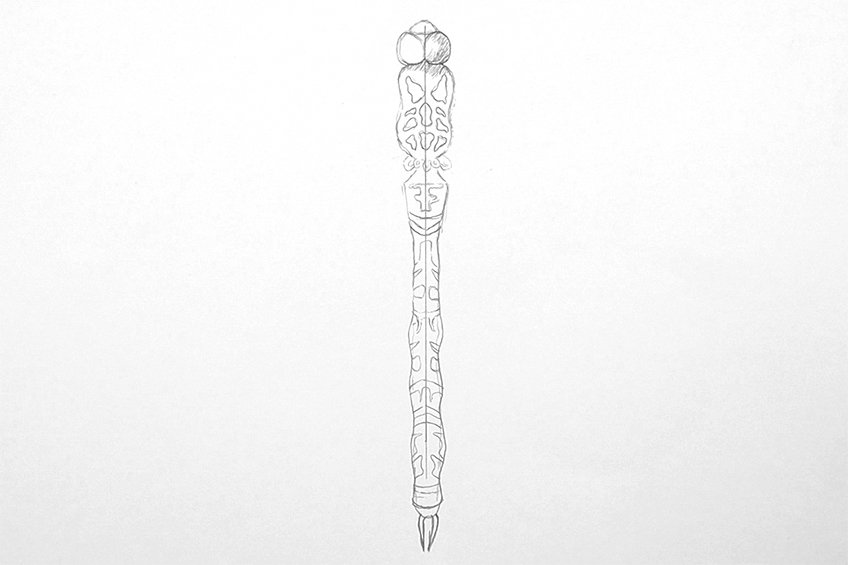
The main aspect to remember is keeping it symmetrical which will result in a realistic effect. Lastly, the bottom of the cerci has two horns that point downward.
Sketching the Legs
We want to carry on using our pencils, where we will now proceed to draw the legs of the dragonfly. The first two legs will sprout from the eyes and will have a subtle arch shape. The legs should be symmetrical on each side of the dragonfly.
The second pair of legs will follow suit and be formed in the same shape as the first pair, except they will sprout from the sides of the thorax.
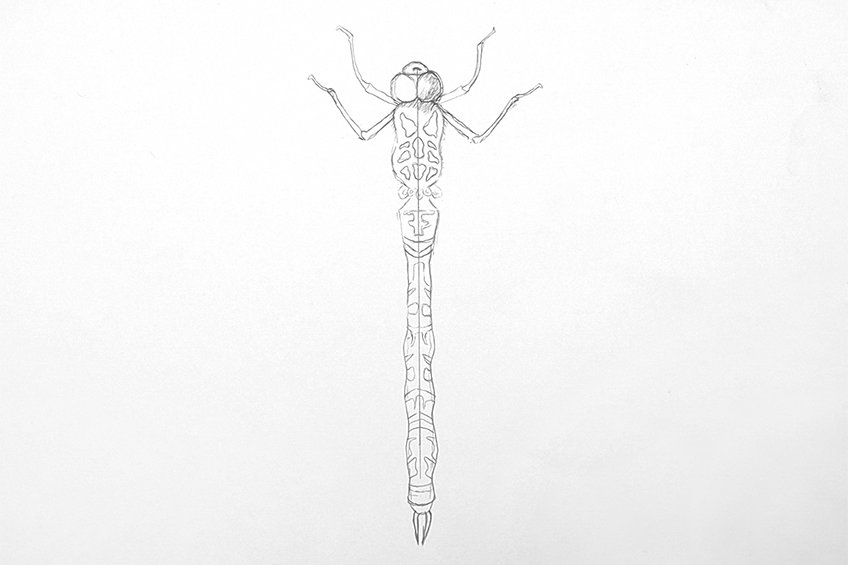
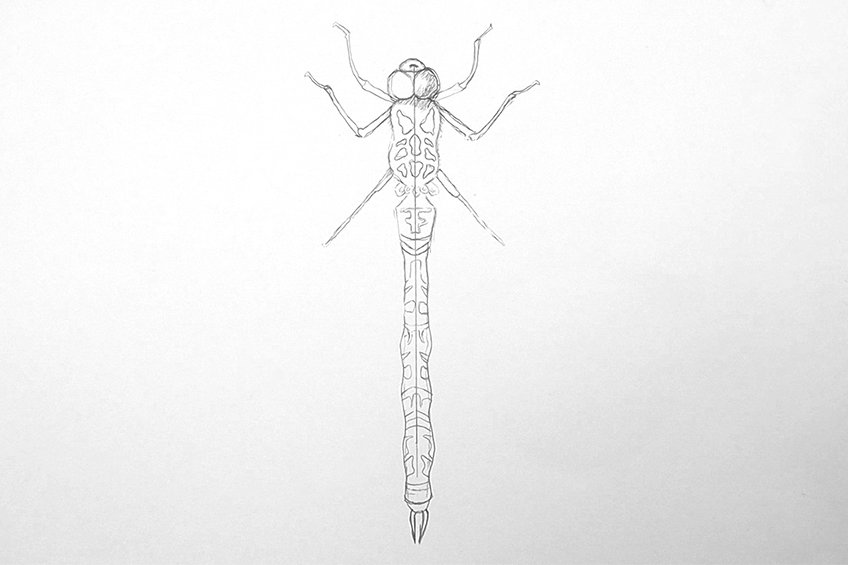
Sketching the Wings
We will start with the upper or forewings first, which can be drawn with our pencils. The shape of the wings could be seen as a spear-head shape that sprouts from the sides of the thorax in a horizontal fashion.
They should be around the same length as the full body of the dragonfly.

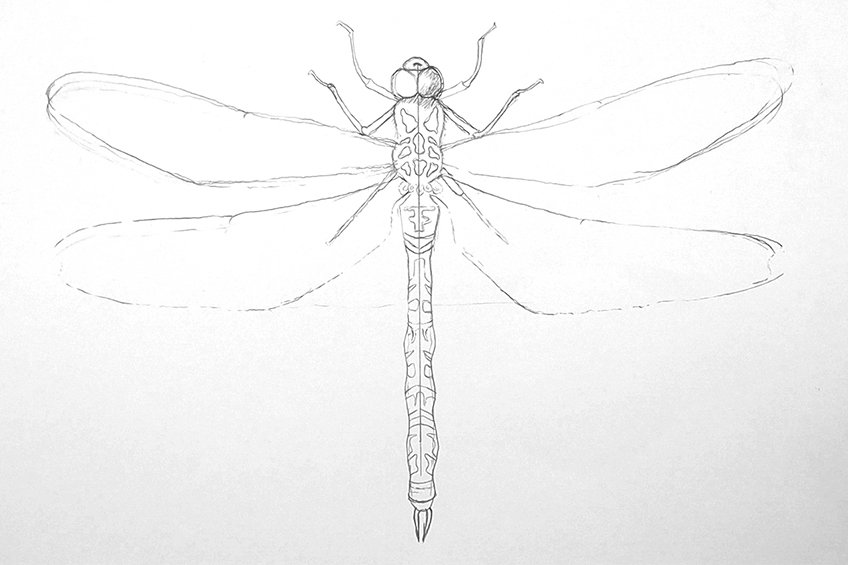
They will start as thick lines that will get thinner and fainter as they move throughout the wings.
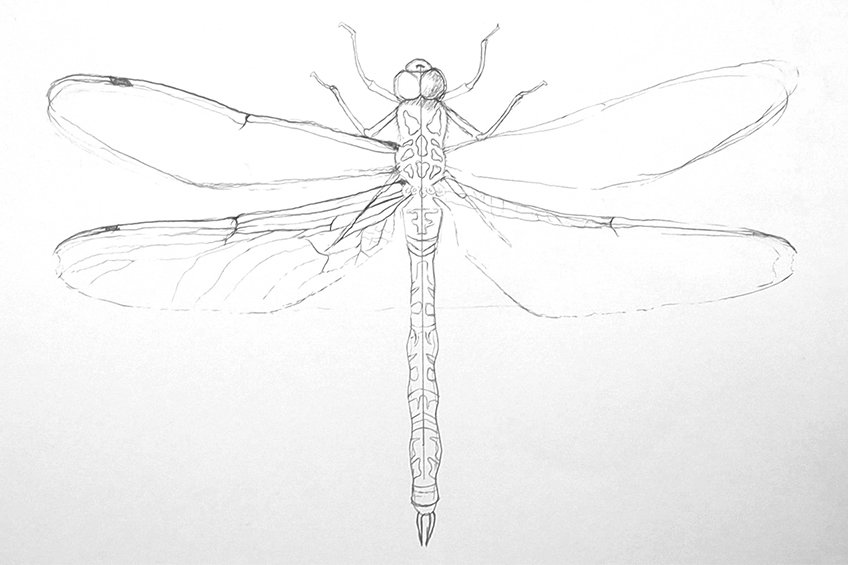
The top line or ridge of each wing should also be thicker and darker than the bottom line or ridge of each wing.
You can play around with how you allow the lines to disperse within each wing. Try to remember that the line structure can be sporadic and have an inconsistency that looks similar to branches on a tree. However, as long as the thicker lines remain near the thorax and the top of the wings.
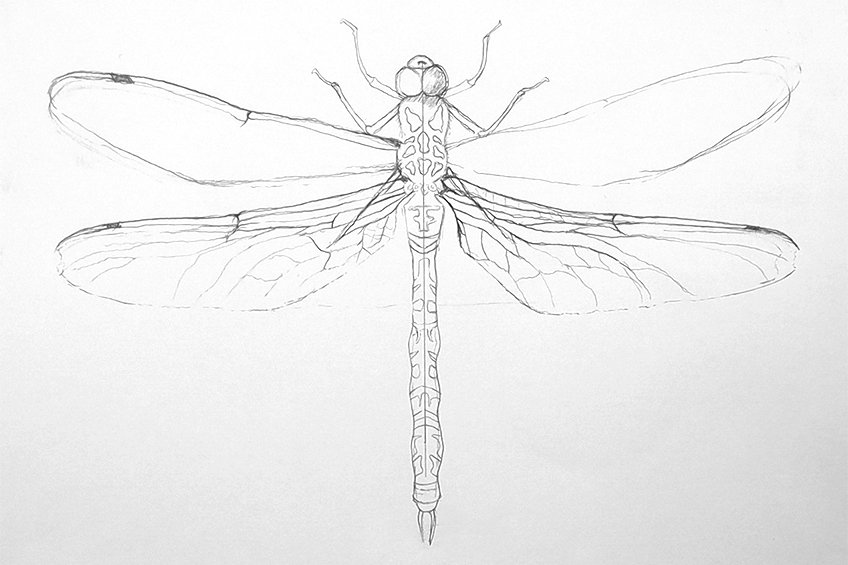
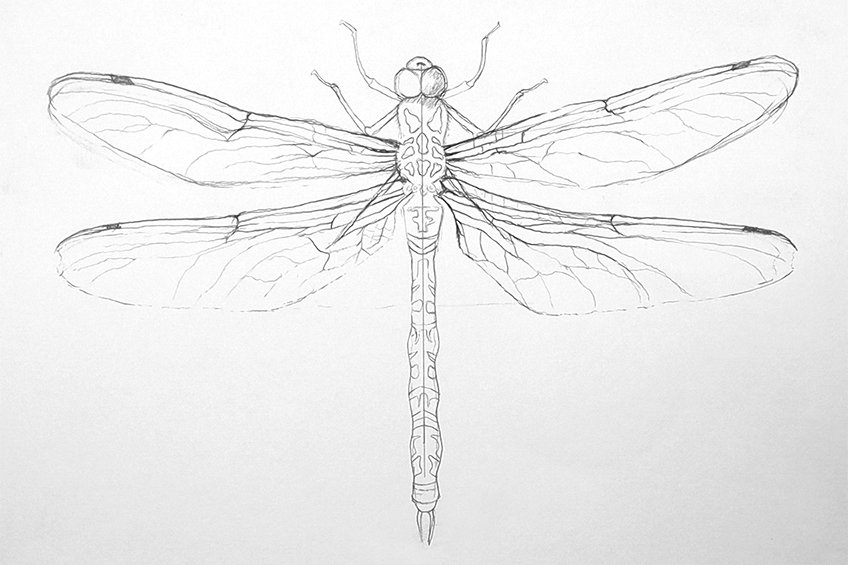
Again, a good suggestion would be to look at an image of a dragonfly on the internet to get an accurate sense of how the wings are formed and how the veins are dispersed throughout the wings.
Shading the Body with Ballpoint Pen
Dragonflies are predominantly black in their color and a ballpoint pen is a great way to add shading whilst keeping a dark vivid tonal value in the insect. We can start near the eyes and upper thorax; we can make the eyes predominantly black with hints of white to suggest a shine.
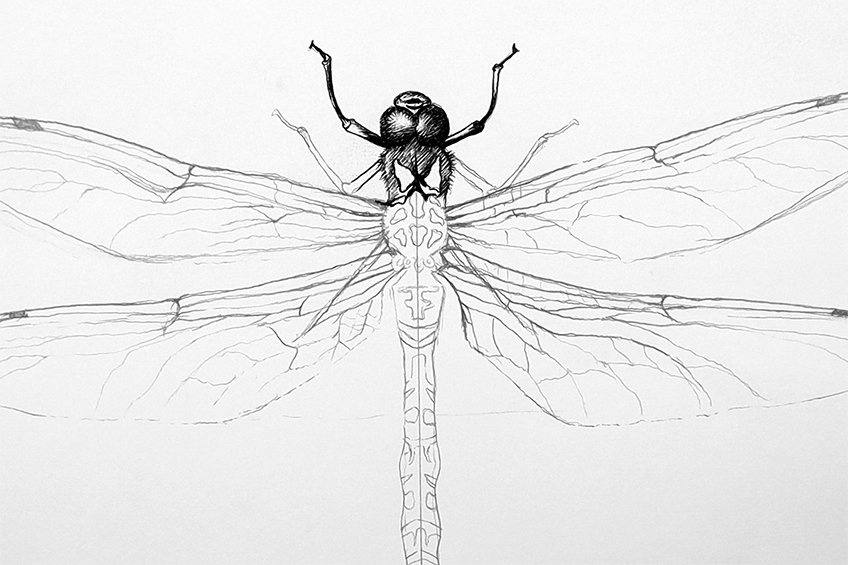
This will give the legs a more three-dimensional quality as it will suggest shine on the smooth exoskeleton. Around the thorax, you can add little lines to give the dragonfly a furry quality.

We want to leave them white for adding color to them later on in the tutorial.

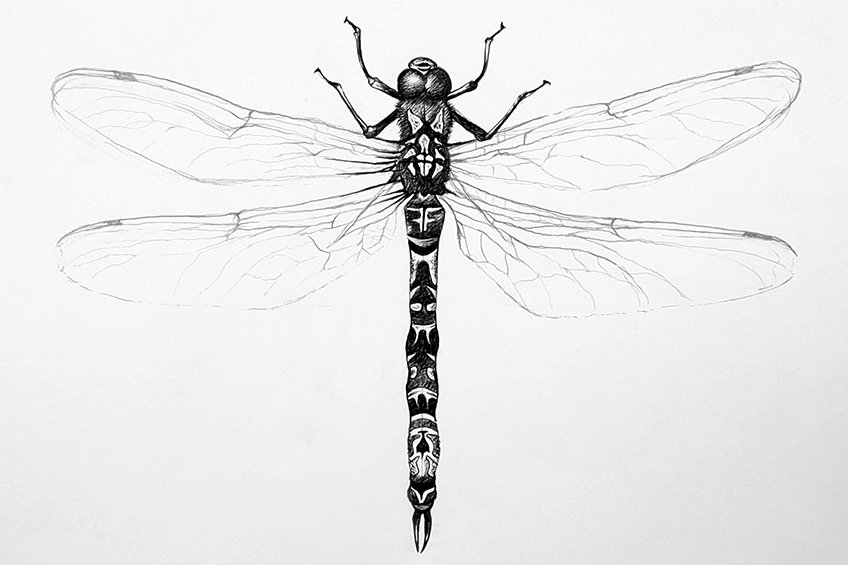
However, you just don’t want to color them in or shade them in completely.
Filling In the Wings with a Ballpoint Pen
With the wings, the process is a little simpler because we have already drawn all the lines with our pencils. However, this time will simply go over all the lines with our pens. We want to darken and thicken the lines near the thorax and along the top of the wings.
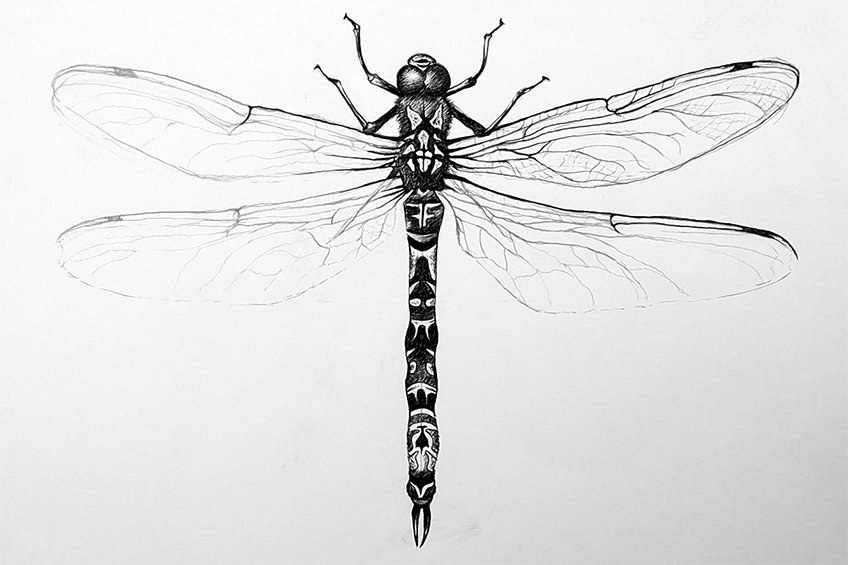
The lines don’t need to be thick throughout the whole wing, just near the top and near the thorax.
Near the top of the wings, at the tip of the spearhead shape, we can draw a dark block which is called the pterostigma. These are iconic features within the wings of a dragonfly and are placed at the top of all four wings near the edge of each wing.

We don’t need to draw this perfect, but rather add a few light lines to suggest this quality within the wings.
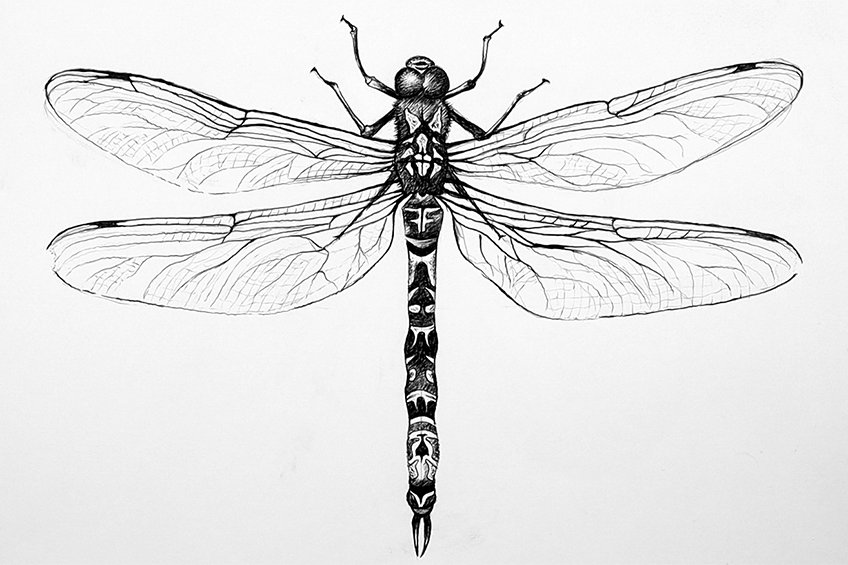
Adding Some Color
We can now add some color to the dragonfly drawing using simple coloring pencils. We can do this by selecting two colors, as dragonflies are never too colorful but rather have a set of two colors within their bodies.
We can then simply color in the patterns that we have left open and untouched.
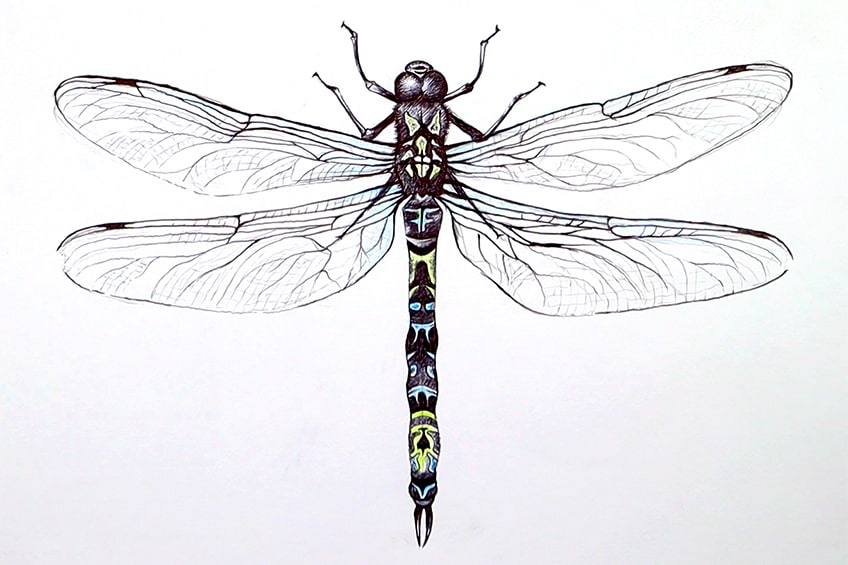
And there you have it! A simple tutorial on how to draw a dragonfly.
Tips to Remember
- Work out the dragonfly sketch in pencil first. Make sure you have the drawing captured in pencil before moving on to using a pen.
- Symmetry is key. We want to keep symmetry through all the features; however, we can change details slightly within the wing’s web structure.
- Keep your pencil sharp. You want to make sure you capture the little shapes and patterns within the insect’s body as accurately as possible.
- Take your time when drawing with a pen. The process of drawing with a pen is not difficult but can come with subtle mistakes if we don’t concentrate.
- Be careful with the wings. Not all the lines within the wings are dark and thick, this means we want to be careful when adding thin and lighter lines with our pens.
- Take a break. A dragonfly drawing does come with some fine detailing which can get strenuous. So, remember to take a break.
Learning how to draw a dragonfly is not that difficult and once you understand the process it is quite easy to create a realistic dragonfly drawing. Dragonfly art is really beautiful and once you know how to draw the different features correctly, you can transform a simple dragonfly sketch into a realistic and interesting dragonfly illustration. Now that you know the process play around with how you can use your dragonfly art for different projects and ideas.
Frequently Asked Questions
How Do You Draw Dragonfly Wings?
Dragonfly wings are quite a unique structure with a web-like or vein-like aesthetic. The wings are a spear shape with a set of veins that run from the body and disperse throughout the wings. The thickest line should always be along the top ridge of the wings as well as closest to the body of the dragonfly. These lines then get thinner as they move into the wings and towards the bottom of the wings. The web lines get thinner and lighter as they move towards the bottom of the wings. You want to make sure that you have a variety of thick and thin lines placed correctly within the wings, which will result in a more realistic dragonfly drawing. With dragonfly art, the wings are quite specific, which means we want to capture the transition between thick and thin lines as adequately as possible. Making sure the vein-like lines are thicker near the body and thinner as they disperse throughout the wings is essential for an accurate dragonfly drawing.
How Do You Draw the Body of the Dragonfly?
As you learn how to draw a dragonfly, you will realize that the dragonfly’s body looks similar to that of a patterned stick. A good idea is to think of it as a totem stick or a stick with different patterns on it, which makes it quite easy to draw. The best way to start is with a simple vertical line, which you then use to draw the body along. You use the line to guide you as you draw a symmetrical body shape along the vertical line, making sure the little curves are the same on each side of the line. From there, you can play around with the patterns that you draw within the dragon fly’s body. The most important key aspect is that you keep the shape of the body as well as the patterns within the body as symmetrical as possible. This will result in a more realistic dragonfly drawing. Lastly, you can keep the structure predominantly black, whilst having the patterns colored in with whichever colors you would like.
Matthew Matthysen is an educated multidisciplinary artist and illustrator. He successfully completed his art degree at the University of Witwatersrand in South Africa, majoring in art history and contemporary drawing. The focus of his thesis was to explore the philosophical implications of the macro and micro-universe on the human experience. Matthew uses diverse media, such as written and hands-on components, to explore various approaches that are on the border between philosophy and science.
Matthew organized various exhibitions before and during his years as a student and is still passionate about doing so today. He currently works as a freelance artist and writer in various fields. He also has a permanent position at a renowned online gallery (ArtGazette) where he produces various works on commission. As a freelance artist, he creates several series and successfully sells them to galleries and collectors. He loves to use his work and skills in various fields of interest.
Matthew has been creating drawing and painting tutorials since the relaunch in 2020. Through his involvement with artincontext.org, he has been able to deepen his knowledge of various painting mediums. For example, watercolor techniques, calligraphy and lately digital drawing, which is becoming more and more popular.
Learn more about Matthew Matthysen and the Art in Context Team.
Cite this Article
Matthew, Matthysen, “How to Draw a Dragonfly – Realistic Drawing Tutorial.” Art in Context. July 8, 2022. URL: https://artincontext.org/how-to-draw-a-dragonfly/
Matthysen, M. (2022, 8 July). How to Draw a Dragonfly – Realistic Drawing Tutorial. Art in Context. https://artincontext.org/how-to-draw-a-dragonfly/
Matthysen, Matthew. “How to Draw a Dragonfly – Realistic Drawing Tutorial.” Art in Context, July 8, 2022. https://artincontext.org/how-to-draw-a-dragonfly/.


